An online exhibition inspired by the theatrical design maverick Jeanetta Cochrane; exploring her legacy through the sartorial and the theatrical. #EmbodyTheCharacter
Don't wanna be here? Send us removal request.
Photo
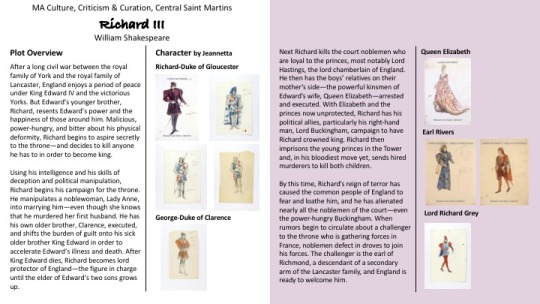
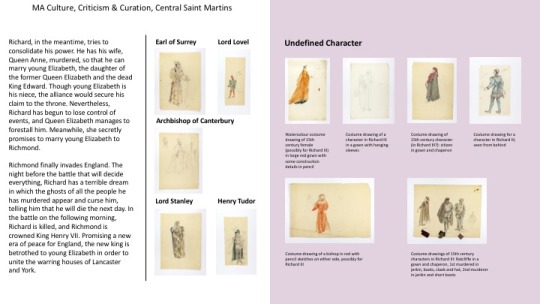
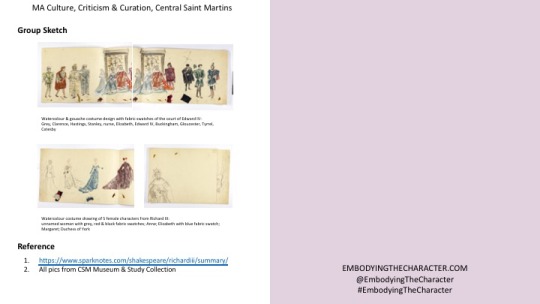
Meet the characters...
Richard III
3 notes
·
View notes
Photo





Thy name is woman: female Hamlets of stage and screen (x)
from top l-r: Charlotte Charke (18th century), Sarah Bernhardt (1899), Asta Nielsen (1920), Frances de la Tour (1979), Ruth Mitchell (1992)
165 notes
·
View notes
Video
youtube
ATC Actors and Costume
Costume designers Elizabeth Whiting and Adrian Hailwood talk about their design process for creating costume from historical periods which fits Auckland Theatre Company's particular approach to plays with historical settings.
1 note
·
View note
Text
Costume and embodiment
Thanks to costumes, individuals become characters in theatrical productions. The audience understands this process of becoming because in their own lives, albeit on a smaller scale, clothing has certainly acted as a transformative tool. Imagine back to playing dress-up as a kid, a simple twig can become a sword which turns a child into a soldier, a pirate, a knight. The character the child identifies with then influences the acts they’ll put on in their game of make believe. Now cut back to theatre—costumes fulfil a similar role; costumes are a tool that transform an actor’s embodiment in order to bring to life their performance.
Embodiment as key to understanding one’s self and one’s perception of being in the world is an idea put forth by French philosopher Maurice Merleau-Ponty. It is through the performance of a body that Merleau-Ponty states, ‘I am at grips with a world’ (1962). In his model, the body and its processes of actions are seen as making up consciousness, which in turn solidifies a subjective self. In other words, we are creating a world through action while at the same time as we perceive that we are within it. This idea of creating/perceiving a world through bodily actions explains why certain acting pedagogies have drawn on Merleau-Ponty’s theories to inform their craft. Dr. Janys Hayes, a lecturer on performance, has explained that acting is relational: between the actor and their body, the actor and their trainers, and finally between the actor and the audience. Within these relations there are partial narratives that are only revealed through actions, or as Hayes says, “we are revealed to others through our bodily performances in ways which we ourselves do not have access (2010).”
So, an actor’s bodily actions create the world that the audience will then relate to and perceive. Which circles back to costume and the effect it has on the body and thus, how clothing effects the overall performance. Costume communicates gender, age, status, personality; all factors which shape the actor’s performance. Beyond these conscious decisions there are simultaneous unconscious enactments, such as how a bodice restrains a lady in waiting, or how metal armor adds heft and presence to the movements of a brave knight, or even still how a crown placed on a queen or king causes their head to be held a little higher. In major and minor respects, costuming is a key determinant in creating the fantastical world spectators are invited to inhabit.
Hayes, Janys, The Knowing Body: Yat Malmgren's Acting Technique, 2010.
Merleau-Ponty, Maurice, The Phenomenology of Perception, trans. C Smith, 1962.
0 notes
Photo



Introducing, Jeremy Fetch...
Jeremy is a character in William Congreve’s Love for Love (1695). As the protagonist’s (Valentine) servant, he often jokes about wishing to be released from his contract. Jeremy feels himself to be above servant status and mentions twice that he has been “at Cambridge” (albeit as a servant) and has picked up some education from his master there. Valentine confides in him and uses him to advance his plans. In the first act, he is quite impudent to Valentine, making fun of him and even criticizing his master’s refusal to pay his debts. In act 4, though, it is Jeremy who is the intermediary between Valentine and the people to whom Valentine wishes to appear insane. Jeremy’s purported intelligence and education are generally undercut by the other characters, who scoff at his pretense. In a scene not depicted on stage, we learn that Jeremy is quite clever, indeed: he tricks Tattle and Mrs. Frail into marrying each other, when they both were attempting to trick others into marrying them (Tattle sought Angelica’s hand, while Mrs. Frail pursued Ben).
A history of dress...
1700’s Meanswear At the beginning of the 18th century the male silhouette differed greatly from that of today. A typical outfit consisted of a full-skirted knee-length coat, knee breeches, a vest or long waistcoat (which could be sleeved), a linen shirt with frills and linen underdrawers. Lower legs showed and were an important part of the silhouette. Men wore silk stockings and leather shoes with stacked heels of low or medium height. The whole ensemble would have been topped by a shoulder-length full-bottomed wig and a tricorne (three-cornered) hat with an upturned brim.

(image source?)
As the century progressed, the male silhouette slowly changed. By the middle of the century the wig was usually tied back (known as the tye or bag wig). By the end of the century it was out of fashion altogether except for the most formal occasions. Undergarments and knee breeches did not change very much. Coat skirts gradually became less full and the front was cut in a curved line towards the back. Waistcoats became shorter. The upper leg began to show more and more and by the end of the century breeches fitted better because they were often made of knitted silk. Shoes became low-heeled with pointed toes and were fastened with a detachable buckle and straps or ribbon on the vamp (the upper front part of a boot or shoe).

1. Costume design for Jeremy Fetch by Jeanetta Cochrane. Production date unknown. Image courtesy of CSM Museum & Study Collection.
2. Carl Prekopp as Jeremy Fetch, Swan Theatre (2015/16).
3. Chad Bradford as Jeremy Fetch, American Shakespeare Centre (2016).
0 notes
Text
Interview with CSM Curator Anna Buruma
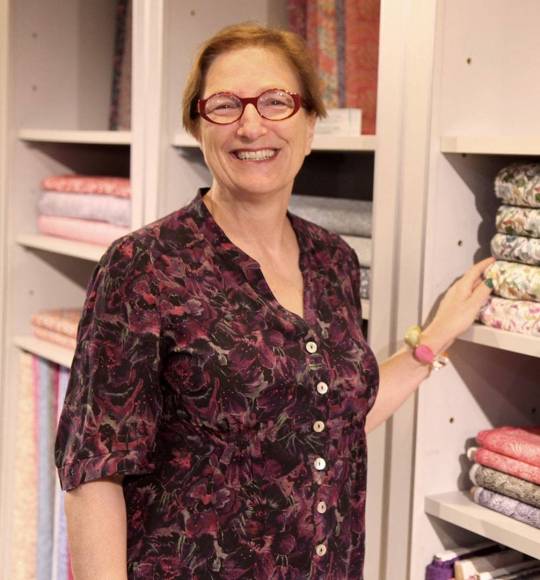
Anna Buruma trained as a theatre designer at Central School of Art & Design where Jeanetta Cochrane taught, albeit many years before. She worked in the theatre and later as a costume designer for television and film. She later studied the history of dress at the Courtauld Institute, now Anna works as a curator and freelance researcher.
What does your role of archivist and curator involve?
My work is primarily concerned with Collections Management. Making sure the collection is safe, that we know where everything is located, that objects are accessioned properly (or listed), and that we know as much as possible about each object. All this needs to be documented so that all staff have this knowledge, when any of us is unavailable. I also work with my colleagues on exhibitions, I answer queries from our visitors and also talk to visiting groups.
How did you discover Jeannetta Cochrane’s teachings?
I was a student many years ago at Central School of Art and Design, studying theatre design (now Performance Design). This was a course that was set up by Jeannetta Cochrane and I was taught by people who had been her students or had been students of her students. So in some ways I was taught many of the things that they were taught.
Do you think her influence is still relevant for today’s teachings on historical costume?
She thought was extremely important for a costume designer to know about the history of dress. There is a fashion in all disciplines and that is true of costume design as well. At present there seems to be less emphasis on Costume History, so although I think it should still be relevant, it is something that we will have to wait for when fashion changes again.
What is your favourite piece from the Cochrane archive?
I like the costume designs she did in the 1940s for School of Scandal and Love for Love.
What’s the biggest challenge when curating a costume/garment exhibition?
Working with any garments in an exhibition is a challenge as they are generally made with textiles, which are so very sensitive to light. Garments are meant to be worn and to move and so it is very difficult to convey the way they would look on a real body instead of a mannequin. Theatre costume is often made with even more fragile materials than fashion ones, and so conservation becomes an even more relevant issue.
What’s the most important aspect on being an archivist?
To record the collection you are looking after in such a way that it is made accessible.
Why is the archive considered an integral part to curating?
The archive is where the documents will be which will tell the story of the objects in the collection.
What are you most excited to see from this Jeannetta Cochrane project?
I am very interested to see what you make of it, after having explored this rather formidable and influential woman through the material in one box.
0 notes
Video
tumblr
She Stoops to Conquer - Creating 18th-Century Costumes
Olivier nominated designer Mark Thompson talks about his designs for the gorgeous 18th century costumes in Jamie Lloyd's production of She Stoops to Conquer at the National Theatre. The film features David Fynn and Cush Jumbo talking about getting into their costumes and into character before the start of a show. (source)
--National Theatre, London UK
1 note
·
View note
Photo

Costume design by David Walker for Fiordiligi in Mozart's opera, Cosi fan tutte, Royal Opera House, Covent Garden, 1968.
“David Walker (1934-2008) studied design at the Central School of Art under Jeanetta Cochrane, from whom he learned the importance of a thorough knowledge of historical dress. He began his career as a costume cutter at Glyndebourne, then worked principally as a costume designer, first for Joan Littlewood's Liverpool Theatre Workshop and Theatre Workshop, Stratford East, in 1960, later at the Royal Court Theatre, the Royal Shakespeare Company and the Royal Ballet. He became one of the world's leading designers, especially acclaimed for opera and ballet, creating productions for every major opera house and ballet company. Walker's skill lay in the interpreting of historic dress in theatrical terms, working in a highly imaginative way with fabrics and trimmings while remaining true to the period in which the production was set. His obituary in the Guardian (25 March 2009) noted that 'colleagues admired Walker's pragmatism and ability to produce the effect of luxury on a tight budget.'
The 1968 production of Cosi fan Tutte was the Royal Opera's first staging of Mozart's opera. The work had been considered more appropriate for smaller theatres and had only been presented at Covent Garden by a visiting company, the Viennese State Opera in 1947. Directed by John Copley, the new production was a success with reviewers. Philip Hope-Wallace. writing in the Guardian (8 July 1968), felt that 'the scale, in sound and in comic force, has been judged to a nicety' and praised Henry Bardon's settings ('Neopolitan yet as pale washed and biscuit coloured as an aquatint by George Morland') and David Walker's costumes ('unlike so much we see in opera today, never lurid fancy-dress'). The production stayed in the Royal Opera House repertory until 1986. On its opening night Fiordiligi was sung by Pilar Lorengar.”
-- Victoria & Albert Museum Collections, London, UK
0 notes
Photo
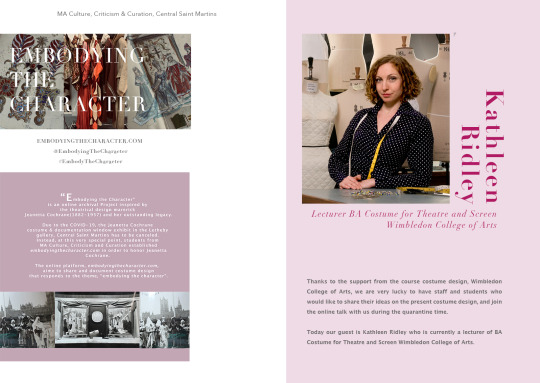


Online interview with Kathleen Ridley, lecturer BA Costume for Theatre and Screen, Wimbledon College of Arts.
“Embodying the Character”, an online An online Archival project inspired by the theatrical design marveick, Jeanetta Cochrane and her outstading legacy.
0 notes
Video
tumblr
Costume design through the centuries: Sketches by Jeanetta Cochrane
1 note
·
View note
Photo
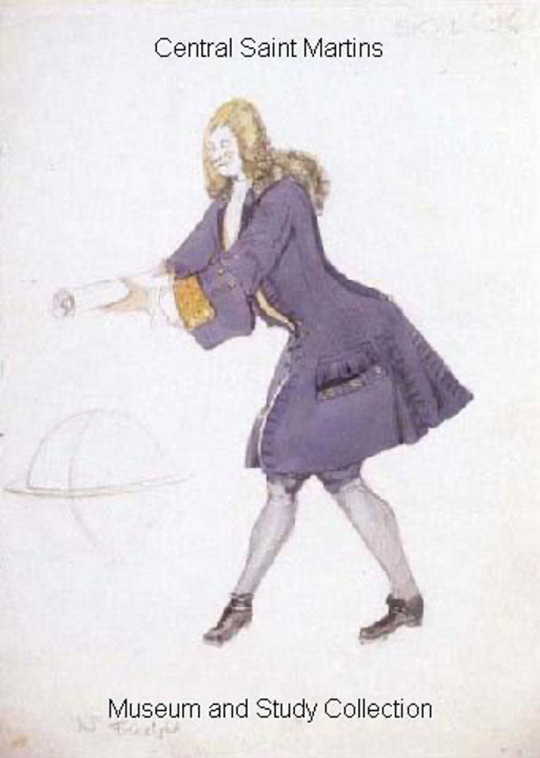
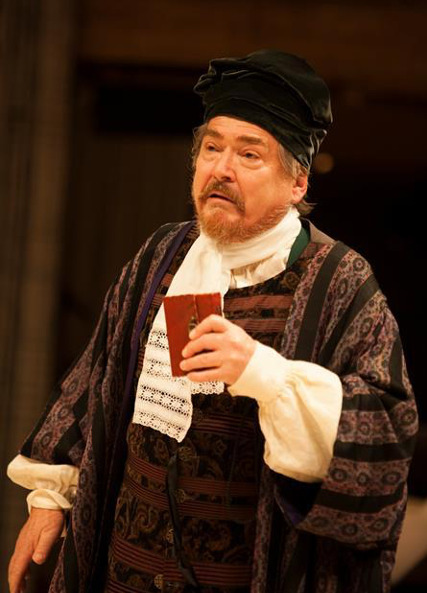
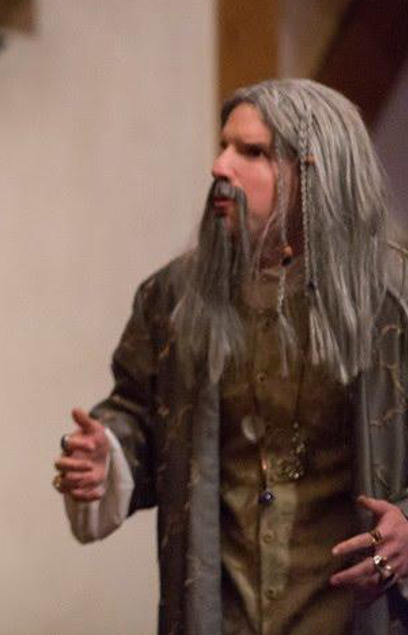
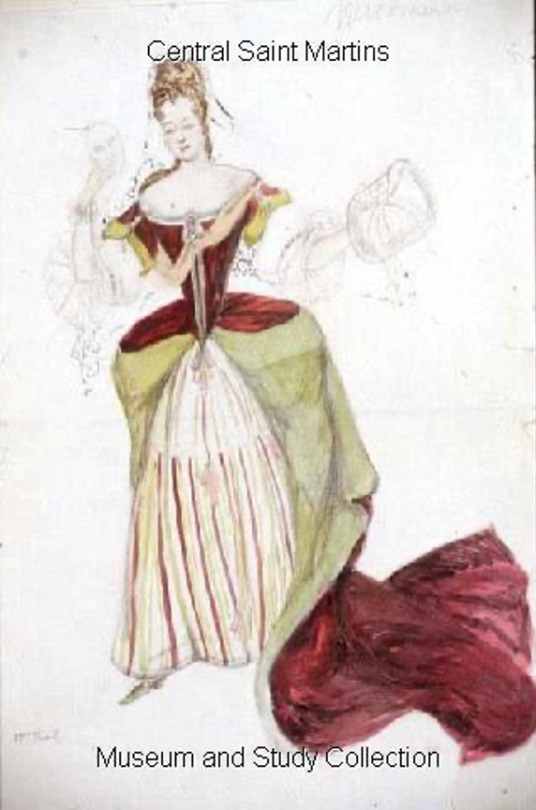


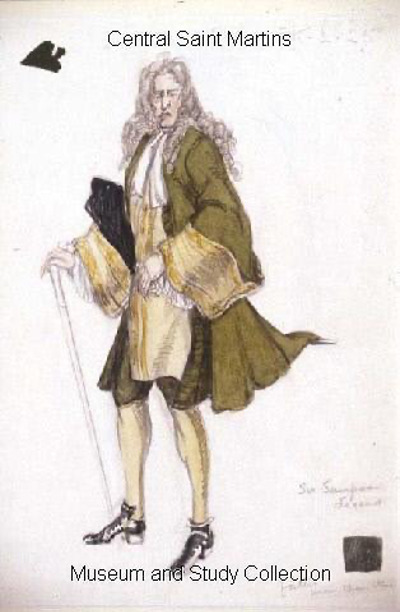


Tracing a history of costume design...
Love for Love (1695)
A comedy by William Congreve, produced and published in 1695. Thomas Betterton and Anne Bracegirdle played the parts of Valentine and Angelica.
Valentine is a fashionable man-about-town whose extravagance has led him into debt. His father, Sir SampsonLegend, agrees to pay the debts only if Valentine will sign his inheritance away to his younger brother, Ben, a sailor. Valentine has to agree but, realizing that he faces ruin, pleads and even feigns madness to avoid signing the bond. Angelica, whom he has been unsuccessfully courting, intervenes. She uses her charms to extract a proposal of marriage from Sir Sampson, and gets possession of the bond. Valentine, believing that she will marry his father, despairs and declares himself willing to sign. Angelica then reveals her plot, declares her love for Valentine and tears up the bond. Meanwhile, the independent-minded Ben has baulked at Sir Sampson's plan to marry him to Miss Prue, a foolish country girl. The plot involves some diverting minor characters, including Valentine's resourceful servant Jeremy and the amorous Mrs Frail. (reference)
Meet the characters...
Mr. Foresight is Angelica’s uncle. He is a blowhard obsessed with astrological omens and other such pseudoscience. From the second act on, he interprets everyone’s comments as veiled knowledge about Mrs. Foresight’s infidelities. His name is clearly ironic: all of his astrological readings and divinations are aimed at providing him with foresight, or a knowledge of the future, but he is probably the least perceptive character in the play.
1. Costume design for Mr. Foresight by Jeanetta Cochrane. Production date unknown. Image courtesy of CSM Museum & Study Collection.
2. Michael Thomas as Mr. Foresight Swan Theatre (2015/16).
3. Aidan O’Reilly as Mr. Foresight, American Shakespeare Centre (2016).
Mrs. Frail is Mrs. Foresight’s sister. She is unmarried and in the market for a husband, and, before the play opens, she has already had an affair with Tattle. However, Mrs. Foresight feels that she behaves much too promiscuously to land a worthy husband. As a result, the two of them hatch a plan to land Ben as a husband for Mrs. Frail. Their plan fails, however, and Mrs. Frail ends up married to Tattle. She is hardly “frail”; she is a calculating and headstrong woman who is not timid about going after what she wants: Ben’s fortune.
4. Costume design for Yvonne Arnaud as Mrs. Frail by Jeanetta Cochrane (1940s). Image courtesy of CSM Museum & Study Collection.
5. Ginna Hoben as Mrs. Frail, American Shakespeare Center (2016).
6. Zoe Waites as Mrs. Frail, Swan Theatre (2015/16).
Sir Sampson is Benjamin and Valentine’s father. He has a considerable amount of money and resents the fact that Valentine has been running through his estate with his fast living. In response, he offers Valentine a deal: sign over his future inheritance to his brother and Sir Sampson will give him four thousand pounds on the spot. Valentine takes the four thousand pounds in advance but feigns insanity to avoid signing the papers, which infuriates Sir Sampson.
7. Costume design for Sir Sampson by Jeanetta Cochrane (1940s). Image courtesy of CSM Museum & Study Collection.
8. Alan Horsfield as Sir Sampson (1989).
9. Nicholas Le Prevost as Sir Sampson, Swan Theatre (2015/16).

Costume design by Jeanetta Cochrane (1943). Image courtesy of CSM Museum & Study Collection.
Scandal is Valentine’s closest friend. He is a rake like Valentine but less coldhearted than Valentine at first is. When Valentine expresses disgust that the mother of one of his children did not smother the child, Scandal merely expresses his best wishes for his “Godchild” and sends money. Scandal helps Valentine appear insane for the purpose of winning Angelica. His function is to provide a mellowing influence on Valentine, who, without the presence of Scandal, would be a truly reprehensible character until the final scene of the play. Like most of the other names in the play, his is ironic; of the two friends, Scandal and Valentine, Scandal is by far the less scandalous.

Robert Cavanah as Scandal, Swan Theater (2015/2016).
1 note
·
View note
Text
It is the understanding of the evolution of the shapes and the way they are produced which is imperative to those who would design costumes for the stage or films. Having for many years studied this aspect I am always struck with the simplicity of the process of evolution- the way that one silhouette gradually changes, either swelling or diminishing simply by increasing or curtailing the existing widths of the garment.
–Jeanetta Cochrane
0 notes
Video
youtube
National Theatre: Fifty Years of Costume
Celebrate 50 years of costume at the National Theatre, with this film that looks in detail at the vast array of skills of our department and how costume informs an audience and actor about the world of a play.
The costume department of the National Theatre comprises of fifty-four permanent members of staff and is home to a diverse array of skills including: tailoring; dying and printing techniques; wig-making; costume props; ladies making; hair-dressing; buying; alterations; dressing; make-up; supervising the shows and maintenance of the costumes.
5 notes
·
View notes
Photo









Introducing, Romeo
Romeo Montague is the main protagonist of William Shakespeare's tragedy, The Tragedy of Romeo and Juliet. He is around sixteen, handsome, intelligent, and sensitive, brave and hating violence. His only interest is love. He falls into love with Juliet and cause his death.
As the popularity of Romeo and Juliet, we can see the huge change of costume of Romeo, and this kind of change also reflected the difference aesthetic and value with time. What’s in a Balcony Scene? Luminita Frentiu even wrote a book ‘A Study on Shakespeare’s Romeo and Juliet and its Adaptations’ and analyze the costume of Romeo and Juliet. In most of plays, Romeo wears white shirt, as the white color represents their beautiful, youthful and pure nature and creates a strong contrast with the people around them. In this scene, Romeo is dressed as a knight and Juliet as an angel. ... Romeo's knight costume displays his youthful character, searching for his love.
Tracing developments in costume design...
Because this story is too famous, people always focus Romeo’s passionate love and tragic love and obscure a clear vision of Romeo’s character which is quite complex. Romeo’s impulsive nature Romeo has brazenly crept behind enemy lines Romeo’s ego is dangerously inflated by the power of love he immediately and without real thought about the consequences denies his lineage and heritage, instantly claiming his Montague background is now ‘hateful’. Romeo believe that he can beat fate, and he use lots of religion language to describe and praise Juliet, which means Romeo compared Juliet to god and heaven. Besides, Romeo is also a representative of challenging masculinity at that time. He is governed by emotion rather than reason contemporary female stereotype. Romeo is reluctant to fight with the opposite family.
Here are a few examples to confirm Romeo’s character:
“But, soft! what light through yonder window breaks? It is the east, and Juliet is the sun.”
“Then I defy you, stars.”
“O me, what fray was here? Yet tell me not, for I have heard it all. Here’s much to do with hate, but more with love.”
“Death, that hath suck'd the honey of thy breath hath had no power yet upon thy beauty.”
“ I take thee at thy word. Call me but love, and I’ll be new baptized. Henceforth I never will be Romeo. “
Romeo and Juliet (1591–95)
This play is quite famous, telling a story that an age-old vendetta between two powerful families erupts into bloodshed. The story happened in Verona, a group of masked Montagues risk further conflict by gatecrashing a Capulet party. A young lovesick Romeo Montague falls instantly in love with Juliet Capulet, who is due to marry her father’s choice, the County Paris. With the help of Juliet’s nurse, the women arrange for the couple to marry the next day, but Romeo’s attempt to halt a street fight leads to the death of Juliet’s own cousin, Tybalt, for which Romeo is banished. In a desperate attempt to be reunited with Romeo, Juliet follows the Friar’s plot and fakes her own death. The message fails to reach Romeo, and believing Juliet dead, he takes his life in her tomb. Juliet wakes to find Romeo’s corpse beside her and kills herself. The grieving family agree to end their feud and promise to erect a monument in Romeo and Juliet's memory.
The date of the first performance is unknown, what can be conformed is that it performed before 1597. Richard Burbage was probably the first Romeo, and since 16th century, Romeo and Juliet was always popular in theater.
---- 1. Costume design for Romeo by Jeanetta Cochrane (1940s). Image courtesy of CSM Museum & Study Collection.
2. The Cushman sisters, Charlotte and Susan, as Romeo and Juliet in 1846. Image courtesy of Houghton Library.
3. Romeo (Godfrey Kenton). Photo by Ernest Daniels (c) RSC.
4. Benvolio (Powys Thomas) tells Romeo (|Laurence Harvey) to flee after he has killed Tybalt (Keith Michell) (1954). Angus McBean (c) RSC.
5. Romeo and Juliet, 1958, the Shakespeare Memorial Theatre. Richard Johnson as Romeo. Angus McBean (c) RSC.
6. Romeo (Ian McKellen) is entranced by Juliet at the Capulet ball (1976). Photo by Reg Wilson (c) RSC.
7. Juliet (Clare Holman) and Romeo (Michael Maloney) meet at the Capulet Ball (1992). Photo by Reg Wilson (c) RSC.
8. Romeo (Ray Fearon) at the Capulet's ball (1998). Photo by John Haynes (c) RSC.
9. Juliet (Morven Christie) meets Romeo (Rupert Evans) at the Capulet's ball (2006). Photo by Ellie Kurttz (c) RSC.
References:
https://www.bl.uk/shakespeare/articles/character-analysis-romeo-and-juliet
https://www.youtube.com/watch?v=1Gm8muE0gM0
https://freebooksummary.com/baz-lurhmans-romeo-and-juliet-use-of-costuming-72422
https://www.shakespeare.org.uk/explore-shakespeare/blogs/?tag=romeo-and-juliet
https://en.wikipedia.org/wiki/Romeo_and_Juliet
https://images.rsc.org.uk/action/viewHome
https://www.sparknotes.com/nofear/shakespeare/romeojuliet/page_80/ https://schoolworkhelper.net/romeo-and-juliet-character-analysis-of-romeo-montague/
0 notes















